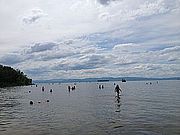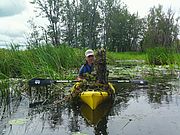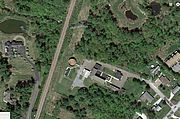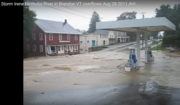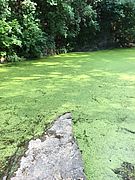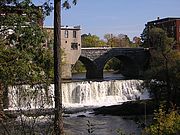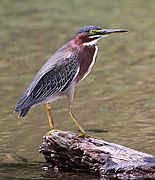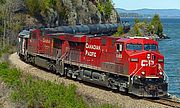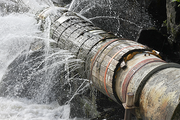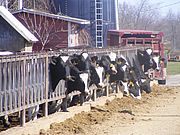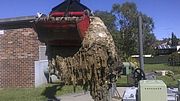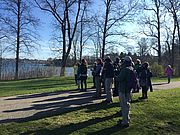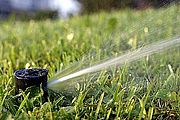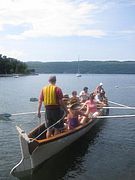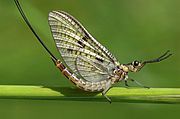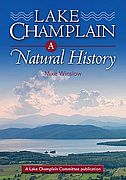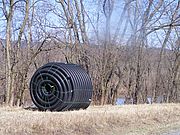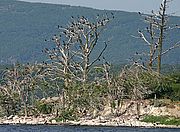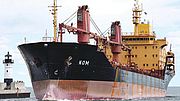What are your highest priorities for clean water investments? The Vermont Clean Water Fund Board has set up an on-line survey to gather public input on priority areas for investing in clean water. The feedback will help shape next year’s Clean Water Fund budget so it's important to let the state know how you would like to see the money spent. Read...
News from Selected Month
On Friday June 17, EPA released a final Total Maximum Daily Load (TMDL) for Lake Champlain. The TMDL sets a pollution budget, defining how much of a given pollutant can enter a water body with water quality standards still being met. Read...
The Vermont Department of Health (VDH) algae tracker is up and running for the summer and LCC staff and volunteers are feeding data into it every day. Health officials use information from the tracker to inform community advisories about harmful blooms occurring in Lake Champlain and other inland lakes. Read...
For most of the last six years LCC has been conducting surveys for aquatic invasive plants and initiating control efforts where possible. We have worked in conjunction with Arrowwood Environmental to map the distribution of European frogbit and water chestnut around the northern portion of Lake Champlain and conduct handpulling removal efforts where applicable. Read...
Will work finally proceed on neutralizing the greatest threat for aquatic invasive species (AIS) introductions the lake faces? The proposed study of an invasive species barrier on the Champlain Canal has been forwarded by the Army Corps of Engineers to their Washington Headquarters. Read...
On July 20, 110,000 gallons of unchlorinated sewage were discharged to Shelburne Bay from the wastewater treatment plant in Shelburne. The discharge occurred due to a “malfunction” at the plant. The situation was resolved and chlorination began the next day. Read...
During Tropical Storm Irene, the Neshobe River in Brandon captured Main Street/Route 7 as its channel when there was so much water coming down that it couldn’t pass underneath the road. Read...
Wondering if you'd recognize cyanobacteria/blue-green algae if you saw it? Want to be more informed about water conditions? Read...
UVM PhD student Keri Bryan Watson has quantified the value of wetlands in protecting downstream areas for flooding. Read...
Great blue herons may garner most of the oohs and aahs of people around the lake, but green herons, their smaller, more colorful cousins also deserve some attention. Read...
Check out our Calendar of Events for more information on the upcoming Water Works Fair, Lake Champlain Open Water Swim and more! Read...
Low water levels, DEC collecting toxics, manure overflow and more! Read...
LCC and partner organizations including the National Wildlife Federation and the Adirondack Council recently released a letter urging Congress to ban oil transportation along Lake Champlain. Read...
Could water infrastructure be gaining support in Washington? The recent inability of Congress to support funding to address the Flint, Michigan drinking water crisis would suggest not, but Politico reports that “there is a growing belief—on both sides of the aisle—that it’s time for the federal government to start investing much more in water infrastructure.” Read...
The Vermont Agency of Agriculture has submitted their plan for Required Agricultural Practices (RAPs) to the Secretary of State on their path to final implementation.
Read...
Lowes and Home Depot recently reached settlement agreements with the New York Attorney General for violations of a 2010 state law designed to reduce pollution from phosphorus lawn fertilizer.Read...
The New York the State Senate considered two regulatory “reform” bills that would seriously impede state agencies’ ability to protect the public and the environment. Read...
Marketing geniuses always search for more ways to separate people from their hard earned money. Read...
Help assess Lake Champlain water conditions around the lake. Complete our<link get-involved volunteers bgamonitors blue-green-algae-monitor-interest-form _blank internal link in current> blue-green algae monitor form if you're interested in monitoring during the 2016 season or want to attend a training session to learn more about the lake. Read...
For the third year running LCC hosted morning bird walks at Oakledge Park in Burlington on Fridays during May. Read...
The mild winter has merged with a dry spring to produce lower than average lake levels. On average May is the month with the highest water levels, but the end of May lake level (95.99 feet on 5/31) is more typical of what we usually see in mid-July. Read...
LCC and other Champlain Basin Education Inititative partners are seeking a few more educators for the upcoming Watershed for Every Classroom five-credit graduate course. Read...
Leave an outside light on during a summer night and you're likely to eventually find one or two large insects with two long appendages at their back sitting placidly by the light. Read...
As summer approaches we all look for a good book to bring along to the beach. Consider a copy of <link learn lccbook>Lake Champlain: A Natural History for yourself or the lake lover among your friends and acquaintances. Read...
Aquatic hitchhikers, oil spill trainings, antibacterials in food and more! Read...
LCC and six other environmental groups sent a joint letter to the Vermont Agencies of Agriculture and Natural Resources commenting on an interim report on the impacts of agricultural tile drains released by the Agencies. Read...
Researchers at UVM have looked at the impacts of changes in student populations on drug residues in Burlington’s wastewater, according to an article in the Burlington Free Press. Christine Vatovec, an environmental science research professor, compared the concentration of drugs in the wastewater over a ten-day period at the end of the spring semester in 2014. Read...
A federal court has ruled that the authority under which hundreds of thousands of double-crested cormorants around the country are killed each year was illegally issued. The ruling calls into question state and federal authority to manage cormorants on Lake Champlain. Read...
The Great Lakes have been the point of introduction for numerous aquatic invasive species over the years. Ocean-going cargo ships would exchange ballast water after arriving from Europe or Asia and accidentally dump the creatures that had survived the passage in a new home. Read...
The phrase “think globally, act locally” has been a mantra of the environmental movement for at least 45 years. It urges people to consider the health of the entire planet when making decisions or taking actions close to home. Read...


